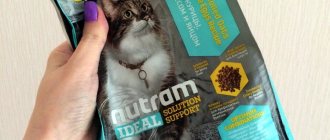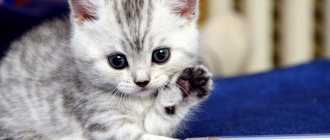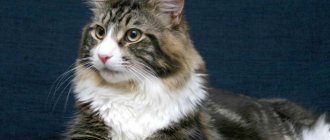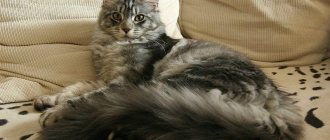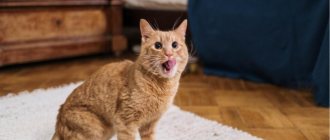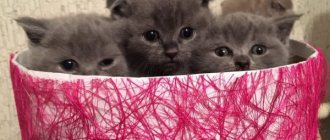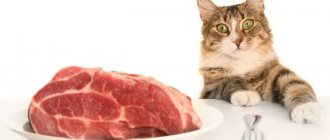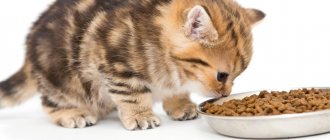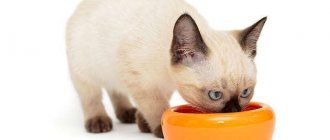Abyssinian owners love to talk about the history of the origin of their pet’s breed and its pickiness in nutrition. With the first point, everything is clear - the name is instantly associated with Egyptian sands, pyramids, sarcophagi and the mysterious rituals of the priests. Opinions often differ on the topic of nutrition. Adherents of a natural diet are opposed by fans of dry food. Amateurs are opposed by professional breeders who are interested in large volumes of products, affordable prices and high quality. It is difficult to understand such a kaleidoscope. Feeding an animal requires a systematic approach, so you need to understand how to properly feed an Abyssinian cat.
Choosing a place and dishes for feeding an Abyssinian cat
The life of a kitten of any breed in a new home begins with organizing a comfort zone for the pet. The Abyssinian chooses a convenient place for himself, and then it is the owner’s responsibility.
Poor food dishes can easily negate the benefits of an Abyssinian cat’s diet.
| Plastic bowls | The cheapest price category in a wide range of colors. Easy to clean, but difficult to wash off. They have a porous structure that retains microscopic feed residues. Experts believe that plastic appliances can cause the development of skin diseases. Sometimes cats don't like the smell coming from plastic. The best option for using such feeding bowls is to regularly replace old dishes with new ones. |
| Glass, porcelain, ceramics | Most often we are talking about ordinary saucers. They do not raise any claims to hygiene. The only negative is fragility. If the bowl of food for an Abyssinian cat is on a hill, the animal is able to throw it off and break it. |
| Metal utensils | Reliable, meets safety requirements. The structure of the material is non-porous, therefore it retains food residues. |
Additionally, a group of monoblock gadgets with automatic dosing of dry food and protection against overeating is considered. But they have not yet gained the trust of cat owners and therefore are not widely used.
All food utensils are available in two universal forms:
- Round, with sides of different heights. Abyssinian cats do not like deep bowls and try to pull food out of them onto the floor. The reason for this behavior is natural instinct and vibrissae (whiskers). The Abyssinians have quite long ones and during feeding they cling to the high sides of the bowl.
- Combined monoblock with two bowls. The form involves the organization of a single place for eating and drinking. If an Abyssinian cat pulls out food, this design is not suitable for the pet. Products fall into the liquid, and subsequently the water deteriorates.
To organize a feeding area, it is recommended to choose a place where the cat can sit comfortably and not get under the owner’s feet. When an animal carefully eats food, a very small space is needed. If the cat scatters food and likes to eat from the floor, the territory will have to be increased.
Important! The easiest way to assess the required space and understand which bowls are suitable for feeding an Abyssinian cat is through experimentation. You should offer your pet various options (a saucer, a round bowl or a combined block) and see which dishes he will eat the food from.
Care items and toys
Before an Abyssinian kitten appears in your home, you need to buy everything you need for it:
- bed or house;
- dishes - bowls for food and water;
- tray;
- filler;
- carrying;
- harness (if you plan to walk);
- scratching post;
- massage comb with silicone tips;
- shampoo for short-haired cats;
- ear care products – lotion, cotton pads;
- nail clipper;
- toothpaste and brush for kittens;
- anti-flea collar;
- toys - mice, balls, glowing balls.
For an Abyssinian kitten, it is better to buy a large tray with high sides. Representatives of this breed are clean and like to bury feces for a long time and actively, with sand scattered around.
If the owners are away from home for a long time, you can purchase 2 toilets and install them in different places in the house. If a cat goes into one litter box a lot, the second one will remain clean. In this case, the risk that the pet will shit in the wrong place due to the reluctance to enter the dirty litter will be minimized.
Natural diet for Abyssinian cats
Abyssinian cats are medium-sized animals, short-haired, active, and lead an active lifestyle. This is not a listing of external data, but an indication of the importance of quality feeding. Nutritional deficiency, which an ordinary fluffy cat can easily hide under a thick fur coat, will be clearly visible in a lean Abyssinian.
In the first place is a diet of natural products. The Abyssinian breed is a direct descendant of wild African and Asian cats, which are genetically predisposed to such a diet.
What foods are needed to feed a cat?
Balanced food for Abyssinian cats should contain the following food groups:
- Protein foods - cattle or poultry meat, offal, fish.
- Carbohydrates – porridges made from cereal plant species.
- Fiber and vitamins - found in vegetables, fruits, and herbs.
Additionally, the natural diet for an Abyssinian cat includes dairy and fermented milk products, eggs, vegetable oil, and yeast.
Rules and regulations for preparing natural food for feeding the Abyssinian cat
The following diet is recommended for adult cats of any breed (based on 1 meal):
| Product | Weight (g) | Periodicity |
| Beef meat (frozen raw) | The weight of protein ingredients per feeding does not exceed 120 g. For hyperactive animals, add 20 g of the product. | 3-4 times a week |
| Chicken or other types of poultry | Daily | |
| Poultry and beef by-products (heart, kidneys, stomachs, liver). | 2-3 times a week. Liver can be fed no more than once a week. | |
| Boiled sea fish | 60 g | Cats are given no more than 2 times a week. For cats – up to 1 time or less. |
| Whole milk or low-fat cottage cheese | 100 g 22 g | Daily. For gastrointestinal disorders, switch to fermented milk products. |
| Various vegetables | 50 g | Give with other food 3-5 times a week. |
| Cereals, pasta | 50 g | 3-5 times a week. |
| Egg (yolk) | 1 PC. | No more than 2 times a week. |
| Feed yeast | Products are calculated based on the weight of the animal (about 6 g) | 3-4 times a week. |
| Vegetable oil (mixed with feed) | 6 g | 3-4 times a week. |
The owner must also adhere to additional recommendations regarding feeding:
- If a cat willingly eats fresh herbs and fruits, you should not deprive her of this pleasure. Before use, products must be cleaned and scalded with boiling water.
- It is preferable to choose “noble” varieties of fish to feed your pet - salmon, trout, salmon.
- Fermented milk products can be given without any restrictions on the range, but alternate them and do not overfeed the animal. An Abyssinian cat can be fed cheese no more than once a week.
- It is allowed to feed honey (in small quantities).
- High-quality meat is fed raw, but it is first scalded and cut into small pieces.
- Sometimes you can feed your cat chicken neck. It should be passed through a meat grinder and added to the feed in small quantities.
Important! Feeding an Abyssinian cat with natural products is painstaking work. These animals are prone to overeating and weight gain. The owner needs to control portion sizes.
Nutrition for illnesses
In many clinical diseases, diet is of great importance. Of course, it does not replace medications, but it can speed up the recovery process for a sick pet. Abyssinians are considered a relatively healthy breed; they rarely suffer from genetic diseases. But, like all cats, with age or due to stress or an unbalanced diet, they can develop kidney disease, liver disease, allergies, obesity or gastrointestinal disorders.
Medicinal food for Abyssinian cats
- Hill's Prescription Diet Metabolic + Urinary Feline dry – excess weight, urolithiasis;
- Hill's k/d – kidney diseases;
- Hill's z/d – treatment of food allergies;
- Hill's w/d – colitis, constipation;
- Hill's i/d – gastrointestinal diseases;
- Royal Canin Urinary S/O LP34 – stones in the bladder;
- Royal Canin Fiber Response – constipation;
- Purina Veterinary Diets UR – urolithiasis;
- Purina Veterinary Diets NF – kidney pathology;
- Purina Veterinary Diets OM - obesity.
Important: it is unacceptable to prescribe a therapeutic diet on your own - veterinary food, like medications, must be prescribed by a doctor.
How to feed an Abyssinian cat: ready-made food in the diet
An alternative feeding option is providing meals with dry or wet nutritional formulas. They are produced by major global brands and contain the entire range of components necessary for the health and normal development of a cat of any breed.
Choosing industrial food for the Abyssinian breed
It is advisable to select food for an Abyssinian cat from the premium segment. It is important to consider not only the brand reputation of the brand, but also the type of food suitable for the animal.
- Dry industrial feed pellets should not be too large in size. The jaws of cats of this breed are not very wide and it is uncomfortable for them to bite through large pieces. In addition, there is a risk of damage to the roof of the mouth and gums.
- There are such compositions: regular, low-grain and grain-free. The first contains the dried nutritional components in full. The second and third types of food are distinguished by the complete absence or low amount of grains. This is explained by the fact that in the wild cats do not eat grains, which means they should not be in dry food.
- The third position is wet food. They contain canned products and can serve as an equivalent replacement for granular formulations. At the same time, they have an important advantage - one jar is designed for one-time feeding. This is how the issue of portion size for an Abyssinian cat is resolved.
The convenience of industrial feed is that the energy value and amount of vitamin supplements are indicated on the packaging. Thus, it is possible to control the caloric content and content of useful elements in the diet of Abyssinian cats.
Important! If the owner of an Abyssinian has chosen dry food as the main food, it is necessary to ensure that the food is always in a bowl. Then the cat will not eat enough for future use, for fear of being left without food.
Caring for a newborn kitten
Newborn kittens need special care. They are usually cared for by their mother for the first 2-3 weeks of life. However, there are situations when human help is needed, for example, if the cat gets sick or dies after giving birth.
Newborn kittens have poorly developed thermoregulation, so they need to be warmed. It is advisable to place the brood in a box or box with ventilation holes and put bedding inside. You can use a bottle of warm water wrapped in cloth as a heating pad.
Nutrition
Newborn Abyssinian kittens need proper nutrition. If the cat cannot breastfeed her babies, you will have to buy a cat milk replacer for them.
- in the first week of life, the kitten should eat 5–6 ml every 2 hours;
- in the second week, the interval between meals increases to 2.5 hours, and the serving volume is 8–10 ml;
- in the third week, kittens receive 10-15 ml of formula every 3 hours;
- in the fourth week, night feedings are removed.
Defecation and urination
In the first weeks of life, Abyssinian kittens cannot defecate on their own. After each feeding, the cat usually licks the tummies and genitals of the cubs. So it stimulates the digestion and excretory processes.
Caring for babies who are left without maternal care involves providing assistance in solving problems with urination and bowel movements. In order for kittens to go to the toilet, you need to give them a light massage of the abdomen and anus. The procedure is carried out every time after feeding.
The litter box training process begins when the kittens' eyes open.
Mixed feeding
Combining natural and industrial cat food is not prohibited, but has a number of features. They relate to maintaining a balance of nutrients in the diet. As a rule, the owner gives the cat dry food on weekdays, and on weekends pampers it with something tasty and natural.
In this mode, it is difficult to keep track of the diet, so the menu often goes beyond acceptable limits.
When feeding a mixed diet, you need to monitor the physical condition of Abyssinian cats. If any indicators deteriorate, a combination of diets is excluded and one type of nutrition is left.
About treats for cats
It is impossible not to pamper an Abyssinian who has become a pet with tasty treats. The special treats produced for cats are not food, but they add variety to the regular diet, which has a beneficial effect on the mood and health of the pet. Manufacturers add only natural ingredients (meat, cheese, fish) and healthy vitamins to all sorts of “mnyams” and “mur-r-meladas”. The treat can be either a dessert or a reward for completing a rule or trick, but in no way should it upset the overall nutritional balance. The negative aspects of pampering include: - getting used to tasty things and refusing regular food; - the risk of gaining excess weight due to the caloric content of products; - incompatibility with the main, especially dietary, type of feeding, leading to disorders. The main thing is to let your pet understand that a tasty morsel must be earned. Proper nutrition is the key to the health of Abyssinian cats. A frivolous attitude towards the animal's menu, random feeding without taking into account the needs will lead to problems. Their solution is much more difficult and expensive than caring for high-quality cat food. Remember that not caring about a good diet can bring your pet illness, suffering, and early death of the Abyssinian cat.
Read all about the Abyssinian breed in the Main article
Algorithm for switching to a different diet for Abyssinian cats
The reason for changing the type of food or feed manufacturer may be the following factors:
- reaching puberty;
- pregnancy period;
- sterilization of cats and castration of cats;
- old age and decreased physical activity;
- veterinarian's prescription.
An additional reason is the desire of the owner himself to change the type of food for the cat.
It is not always possible to quickly change a cat's diet. An Abyssinian may not accept a new type of food or refuse it for a long time. Therefore, replacing cat food products must be divided into several stages:
- Gradually change familiar products to new ones. Felinologists do not recommend accelerating the transition period and suggest feeding 25-30% of new ingredients for the first week.
- In the next decade, the replacement of products will be increased daily by 10%. By the end of this period, the change in diet will smoothly complete.
- Do not mix natural and commercial wet food in the same bowl. This makes it difficult to monitor the body's reaction.
- When switching from natural or wet food, the granules need to be slightly soaked. The Abyssinian cat must get used to this type of food.
- The reverse process (switching from pellets to a natural diet) can be difficult. The products do not have an attractive smell, so the cat may initially refuse them. In this case, it is recommended to take a short fasting break (no more than 3 days), and then offer the Abyssinian a new diet.
A cat of any breed tries at least 3 types of food during its life. She gradually gets used to each of them, which makes it easier to change her diet in the future.
Important! Do not try to force feed your Abyssinian cat. This will for a long time perpetuate aversion to products that are “imposed” against desire.
Kitten in a new home
Moving a kitten to a new place is a lot of stress for him. A trip, unfamiliar smells and sounds, the absence of a mother nearby - these factors frighten the baby. Therefore, it is so important to provide him with good care from the very first days of his stay in the apartment.
In order for the kitten to get used to it faster, it is advisable to pick it up from the nursery on Friday. Then he will spend 2 days off under the supervision of the new owner. At first it is recommended to place it in one room, and when the cat gets used to it, open access to other rooms.
Attention! If there are other pets living in the house, you should not immediately introduce them to the Abyssinian cat, so as not to aggravate the situation. First, the kitten must get used to the new environment and owner.
Pet safety
Caring for a kitten also involves ensuring its safety. Abyssinian cats are curious and very active by nature. Therefore, you should not be surprised if your pet gets into the washing machine, trash can or on the hob.
You need to make sure that the kitten does not fall out of the window; it is better to immediately cover the openings with a mosquito net. There should be no small beads, needles, tinsel, threads or other debris lying on the floor that a cat could swallow.
Attention! Toys on a string pose a danger. An angry kitten may become entangled and suffocate. Such items should be removed while the owners are not at home.
Vitamins and mineral supplements to food in the diet of Abyssinian cats
The composition and volume of vitamins, minerals and trace elements must be selected individually, taking into account the age, size and health status of the Abyssinian cat. Standard food necessarily contains potassium, calcium and magnesium, yeast, Omega-3 polyunsaturated fatty acids and an arbitrary combination of vitamins. This is enough to maintain normal pet health.
If difficulties arise with the bones and muscles, skin and coat, immunity or gastrointestinal tract, it is recommended to seek veterinary help. The doctor will prescribe additional vitamin support for the cat or prescribe a separate medicinal food that contains the necessary nutritional supplements.
Antiparasitic treatment and vaccination schedule
Caring for a kitten also includes taking care of its health. Even pets are not immune from the risk of contracting infectious diseases, so they need to be vaccinated. The first vaccination is carried out at the age of 12 weeks.
List of mandatory vaccinations:
- from panleukopenia;
- calcivirosis;
- rabies;
- chlamydia.
Abyssinian cats that will take part in breeding are also vaccinated against leukemia, immunodeficiency and viral peritonitis. Some animals need to be vaccinated against ringworm with the Vakderm or Microderm vaccine to protect against ringworm.
The Abyssinian kitten care program also includes preventive treatment against helminths. It must be carried out 2 weeks before vaccination and, if necessary, 1-2 more times a year. Antihelminthic drugs are given twice with an interval of 10–12 days.
Water in a cat's diet
Fluid intake depends on the type of food and daily food intake.
- Natural food and wet food contain a sufficient concentration of moisture and are its source for the animal’s body.
- Dry granules require more careful attention to the presence of water in the drinking bowl - the cat will need a large amount of liquid.
Regardless of the diet chosen, water should always be available. On average, a cat drinks 40-50 ml of liquid per kilogram of weight per day, but this is a very approximate level.
A clear indicator of a lack of water is the appearance of the coat and trips to the toilet. Shiny, evenly lying hair and 2-4 urinations per day indicate a normal amount of fluid in the diet of a healthy cat.
Why does a cat need castration?
When purchasing a purebred kitten not intended for breeding, it is usually stipulated that it will need to be neutered upon reaching puberty. In this case, the question of the appropriateness of the operation is resolved by itself. If such a clause is not specified in the contract or you bought the animal without documents, the question arises: why castrate an Abyssinian cat, isn’t it dangerous, and won’t he feel “inferior” after losing the ability to reproduce?
In fact, unfulfilled sexual needs cause the animal much more discomfort than a simple operation. As for “fullness,” the cat, in principle, does not know such concepts. He does not fall in love and does not choose, but mates with any female in heat, acting according to his instincts, which are regulated by hormones. If there are no sex hormones, there will be no desire to mate.
Benefits of castration:
- the pet stops marking, calling calls at night stop;
- the likelihood of escaping from home is reduced, and therefore tragic incidents - the possibility of injury and infection;
- the cat’s aggressiveness towards other animals disappears or significantly decreases;
- the risk of diseases such as prostatitis, prostate adenoma, and perianal tumors is minimized.
In addition, according to statistics, castrated individuals live 2-3 years longer in comparison with their counterparts who have retained reproductive function.
Features of feeding and diet of Abyssinian kittens
Nutrition in the first months of life leaves an imprint on the entire subsequent period. Under normal conditions, there is no question of feeding Abyssinian kittens immediately after their birth. They receive mother's milk, and with it immunity and natural strength.
In exceptional cases, babies are transferred to artificial feeding.
Up to a month
An orphaned kitten has a good chance of growing up healthy and strong. The absence of maternal feeding is replaced by:
- diluted goat or cow milk;
- surrogate cat milk;
- special mixtures for this age.
An Abyssinian kitten has to be fed every 2-2.5 hours. Due to active metabolism (metabolism), he experiences a constant need for food and needs regular feeding for up to 1.5 months (including at night).
1 month
During the first 30 days, the kitten’s weight increases 4-10 times: females - 300-600 g, seals - 400-800 g. Under natural conditions, this period is characterized by leaving the mother’s nest and a smooth transition to artificial food.
The diet is gradually expanding to include:
- whole cow or goat milk;
- beef broth;
- boiled minced meat or pureed homemade pate, diluted with water or low-fat broth.
It is important to monitor the amount of food to prevent overeating and regurgitation of leftover food.
2 months (girls weigh 550-980, boys - 0.95-1.5 kg)
Fermented milk products (ryazhenka, yogurt) and raw meat are added to the milk and broth with minced meat. The kitten should be able to handle this food easily and not spit it out. Therefore, before giving an Abyssinian cat natural meat food, it is cut into small pieces.
3 months (girls – 1-1.8 kg, boys – 1.4-2.6 kg)
At this age, mandatory vaccination is carried out, due to which the feeding of the Abyssinian cat may fail with a decrease in appetite. There is no need to be upset about this - the animal will suffer a little stress and return to its normal diet.
Starting from 3 months, a chicken egg yolk is added to the Abyssinian kitten’s diet. It is given separately or mixed with other products. You can replace it with a whole quail egg (raw). Also fed with grated carrots and green apple (puree).
4-6 months (cats – up to 3.6 kg, males – up to 4.5 kg)
By six months, the Abyssinian cat gets used to the food and is fully socialized. At this age, she had already changed her house and settled in a new place.
The diet is approaching a full set of ingredients: meat, fish, offal, vegetables and fruits.
Industrial feed is given in accordance with the manufacturer's recommendations, and dry granules are additionally softened with water.
From 6 months to 1 year
During this period, the young Abyssinian undergoes a complete change of teeth, because of which it is not recommended to keep him on dry food - it is better to give preference to wet, semi-moist products.
Important! By the age of one year, the number of feedings gradually decreases to 2-3 times a day and to the established food norm (0.12-0.15 kg).
Features of feeding Abyssinian kittens
Abyssinian kittens have no problems with food in the first one and a half, or even two months of life - mother's milk is enough. Feed very carefully, in very small portions. Soft food can be offered at one and a half months of age. The number of feedings per day depends on age: - 6 times a day for 120-150 grams - up to 3 months using a children's assortment of ready-made food or natural boiled, pureed products (taking into account baby teeth); - 5 times - after three to five months - medium-hard food is added after the appearance of the second strong teeth; - 4, and soon 3 meals after 5 to 8 months from the “junior” line, and with natural feeding - very finely chopped. - Starting from 8 months of age, young animals, like adults, are invited “to the table” in the morning and evening.
Diet of an older cat
As an animal ages, its diet changes significantly. Before deciding on food for an aged Abyssinian cat, it is necessary to assess its health - the condition of its teeth, coat and musculoskeletal group.
At this age, animals are most often fed wet food (natural or industrial) with the addition of mineral and vitamin components. Castrated and sterilized individuals are prone to weight gain, so the food norm in these groups is strictly observed.
Extra pounds have a bad effect on the cardiovascular system and shorten the life of an Abyssinian.
Tray training
Abyssinians are very smart, so there should be no problems with litter box training. Typically, purebred kittens are transferred to a new owner at the age of 3 months. Until this time, they are raised by the breeder. It is he who teaches his animals the rules of behavior, including the ability to use a tray. The new owner can only show the kitten where the toilet is and make sure that the pet goes there for the first time.
Anyone who breeds Abyssinian cats will have to independently train small kittens to use the litter box. Mother cat helps with this. She uses her example to show kids where to go to the toilet. Sometimes there may be mistakes, but you need to be patient and put the naughty baby in the tray every time.
If your pet persists and cannot be trained, the following recommendation from experienced felinologists will help. You need to moisten a cloth with the kitten's urine and put it in the tray. The animal will smell itself and next time go to the toilet in the right place.
Prohibited foods
The following foods should not be included in the diet of Abyssinian cats:
- pork in any form;
- egg white;
- fats, skin, bones of birds;
- sweet fruits with a high juice content;
- dried, smoked fish and all types of freshwater fish in raw form;
- sugar-containing products and sugar substitutes, caffeine and stimulants;
- baked goods in any form;
- mushrooms.
The main rule is that you cannot feed your Abyssinian cat anything potentially dangerous. Mushrooms cause allergies, chicken skin with a fatty layer leads to weight gain, and raw fish is a breeding ground for worms.
What you should never give to cats
Neither kittens of any age nor adult cats should be offered: - poultry bones: sharp fragments can cause perforation of the stomach and intestines; - any type of pork - such meat immediately increases cholesterol; - fatty foods: the only fat may be a limited amount of vegetable oil; - river fish that has bones and parasites that do not die when cooked; — confectionery products of any kind; - fresh white bread, especially rich bread; - flour dishes - pancakes, pies, pasta; — marinades, pickles of any kind; - fried smoked food, any sausages. It is unacceptable to offer leftover dishes from the hosts’ table or stale food, as well as very liquid soups in large quantities.
How to prepare an animal for castration?
Having decided to castrate your pet, you should first choose a good veterinary clinic. To do this, you can talk to other cat owners or seek advice from the breeder. Having chosen a clinic, contact the doctor and agree on the operation, clarifying the question of the need for a preliminary examination.
As a rule, healthy young animals do not require any special preparation. It is enough to stop feeding the cat 12 hours before surgery and stop giving water 2-3 hours before. This minimizes the risk of vomiting and involuntary bowel movements during anesthesia.
How is the operation performed?
The castration procedure for cats takes no more than half an hour and includes the following steps:
- Visual inspection, temperature measurement.
- Weighing the animal to determine the dose of drugs.
- Introduction to a state of anesthesia.
- Shaving the hair on the skin of the scrotum.
- Treatment of the surgical field with an antiseptic solution.
- Incision of the skin of the scrotum with a scalpel, extraction and removal of the testes.
- Treating the incision sites with an antiseptic.
In most cases, stitches are not required, since the incisions are small. In addition, in the absence of stitches, inflammatory exudate drains better and healing is accelerated. Normally, wounds become covered with a stable crust after 1–2 days and completely heal within a week.
When to castrate an Abyssinian cat?
There is no consensus among experts on this issue. Some veterinary clinics castrate kittens as early as three months. The disadvantage of this approach is that after the operation the development of the genitourinary system stops: the penis and urethra remain underdeveloped. This does not harm a healthy animal in any way, but in the case of sand formation and the development of urolithiasis, it significantly complicates treatment.
It is considered optimal to castrate an Abyssinian cat when he is already 7 months old. At this point, intensive growth has already been completed, and the animal is strong enough to undergo surgery under general anesthesia. It is better to do this before the 9th month.
It is possible later, but in this case changes are already taking place in the hormonal system: testosterone begins to be produced not only in the testicles, but also in other endocrine glands - the pituitary gland and adrenal glands. Therefore, after the operation, the level of male hormones will remain high for quite a long time - up to six months. Consequently, the sexual behavior characteristic of the male will continue for some time. In addition, it should be taken into account that with each year of an animal’s life, anesthetic risks increase.
Sometimes the question arises about castration of a breeding Abyssinian cat after “retirement”. In this case, the approach to the operation must be especially responsible: it is necessary to check the functioning of the internal organs and do a biochemical blood test. Only based on the results of these studies is the final decision made.


